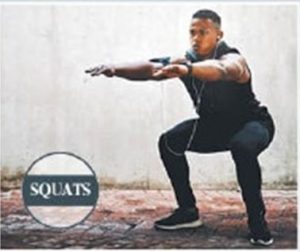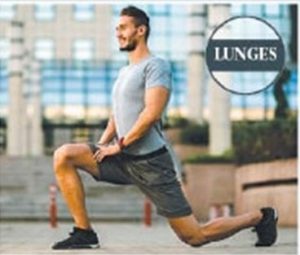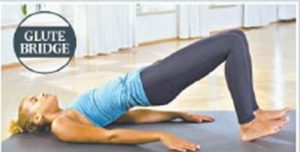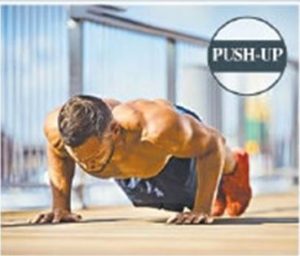How to exercise with correct technique to avoid injury
Data from fitness apps reveals many of us do basic exercises incorrectly.
You diligently perform your push-ups and lunges, but are you doing them correctly? When scientists analysed data from 100,000 downloads of a smartphone app that used motion tracking to check postural position, they found many of the most popular moves were performed so badly that people risked back pain, neck strain and more serious injury.
Using the phone’s camera, the Kaia Personal Trainer app tracks 16 key points on your body as you perform circuits, then compares exercise posture with a “perfect” pose, including the relative positions of your limbs and joints, and the angles between them. In pinpointing the slightest movement errors it provides researchers with an abundance of information, and the scientists have been able to identify the six exercises — squats, lunges, push-ups, the bird-dog, the glute bridge and the plank — that we most perform poorly.
“These are definitely the six that people do wrongly,” says Sammy Margo, a chartered physiotherapist and conditioning expert. “And when you repeatedly have bad form over several weeks or months it could be asking for pain or injury.”
We asked Margo and Dalton Wong, the director of Twenty Two Training and trainer to Jennifer Lawrence and Olivia Colman, where we were going wrong and how to correct our mistakes.
–
Squats


Where we go wrong
“Performed correctly, squats recruit lots of large muscle groups including the glutes, hamstrings and quadriceps muscles, and improve core position and posture — they are one of the best exercises we can do for functional strength,” Margo says.
Where most people go wrong, she adds, is by leaning too far forward or extending the knees over the toes instead of “sitting back” while lowering the body.
“They also think that they must lower their body until thighs are parallel to the floor,” she says. “That’s good if you are used to doing them, but it’s OK to start with a shallow squat if you are not.”
The right way
- Stand with your feet slightly wider than your hips.
- Keep your spine in neutral (maintaining the three natural curves).
- Feel the weight in the heels of your feet.
- Engage your core.
- Breathe deeply, bend at your hips, lower your body and push your bottom back.
- Keep your knees in line with your feet and ensure they do not move inward.
- Look forwards; looking up compresses the spinal discs.
- Lower your body until your hip joint is lower than your knees if you can, or as low as you can manage.
- Breathe out as you come up (it releases pressure on the abdomen), still tensing your body.
- Raise your body by pushing down through your heels.
Top tip: “Press into the heels in order to engage the muscles,” Margo says. “That will allow you to perform the squat and think about going backwards, not forwards.”
Lunges


Where we go wrong
Lunges strengthen, sculpt and build muscles and muscle groups including those in the thighs, buttocks or hamstrings.
“They are very good for developing glute, core and quadriceps strength,” Margo says. “And because of that they will improve posture and also walking and running action.”
Common mistakes include a poor starting posture; your upper body should be upright and head facing forward, and the lunge should not be too far.
“People tend to have their feet too close together, which destabilises the movement, so make sure you keep your feet hip-width,” Margo says. “Let your legs take the weight of the move.”
The right way
- Start in a kneeling position.
- Lunge forward with one leg.
- Shift your weight to the front leg and bring your other knee off the ground.
- Keep your upper body straight and engage your core.
- Keep your front knee over your ankle, not pushed out too far.
- Slowly lower your knee to the ground.
- Return to the starting position and repeat the movement.
Top tip: “As you get stronger, vary the lunge so that you do it in reverse and also to the side (lateral lunge) and as a curtsy, which will strengthen the hips and work the glutes,” Wong says.
“Walking lunges, in which you proceed in a straight line, are great as they integrate the whole body and core to keep balance.”
Bird-dog


Where we go wrong
This exercise works the rectus abdominis and glutes among other muscles that help to create stability of the body.
“You need to extend the opposite arm and leg simultaneously and hold it, but most people lift one arm and the opposite leg too quickly,” Wong says.
Make it a controlled and slower movement and it will force you to create the core tension you need to stabilise the movement.
“Arching the back is also common and can cause back pain, and a lot of people wobble from side to side when stretching the arm and leg out because they haven’t engaged the core,” he says.
The right way
- Start on all fours (shoulders above hands, hips above knees) with your hands and knees touching the ground.
- Extend one leg straight backwards and the opposite arm out straight in front of you in a controlled manner.
- Try to keep your extended arm and leg parallel to the ground.
- Bring your elbow and your knee back underneath your body.
- Extend your arm and leg again.
- Repeat this movement.
Top tip: “Keep your toes in contact with the floor,” Wong says. “This ensures that the glutes are engaged on your stationary leg and your hips stay level.”
–
Glute bridge


Where we go wrong
This is a great exercise for activating the posterior chain muscles at the back of the body, but especially the glutes.
“You really need to extend the hips fully upwards in order to be able to contract the gluteal muscles in the buttocks fully,” Wong says. “And a lot of people don’t do this, which means there is excessive arching of the lower back and stress to the neck and shoulders.”
Nor should you lift your head off the ground to check the movement. “Your head should always remain on the floor.”
The right way
- Lie flat on your back and raise your legs so that your feet are together and flat on the ground.
- Pull your toes up so that only your heels are touching the floor.
- Lift your buttocks off the ground and raise your hips.
- Raise your hips so that your shoulders, buttocks and knees create a straight line.
- Return your upper body, one vertebra at a time, slowly to the ground and repeat.
Top tip: “Think about curling your toes up in your shoes,” Wong says. “And add a mini-band around your knees to hit the glutes more strongly.”
–
Plank


Where we go wrong
The plank recruits the two big rods of muscle, the erector spinae, that run up either side of your spine and the other abdominal muscles.
“There are so many things people do wrong when attempting it,” Margo says. “They adopt poor neck alignment by looking ahead instead of down and they either have a rounded back — often a result of a stiff thoracic spine from lots of desk work — or, as they tense to hold the position, the pelvis tends to sink towards the floor, which places tremendous strain on the back.”
Don’t hold your breath; it exacerbates strain on the lower back.
The right way
- Lie face down with elbows on the ground.
- Raise your body so that you are supported on your forearms and toes. Make sure weight is evenly distributed.
- Keep your elbows at a 90-degree angle and your back straight.
- Tighten your abs by pulling your belly button slightly inward — your body should be parallel to the floor.
- Hold this position.
Top tip: “Don’t become overly obsessed with holding the plank for too long,” Wong says. “Once you can hold the full plank for two minutes with perfect posture, progress to add variations such as raising one arm and one leg.”
Push-up


Where we go wrong
Hand position is important in a push-up and a wider hand position is easier. “Your hands should ideally be shoulder-width apart, but experiment with hand position,” Margo says. “Dipping your upper body before the lower body is another error; you need to tense your buttocks and abdominals to lower yourself.” Keep your head still and looking down rather than forward, which strains the neck.
There is no shame in attempting a modified push-up with knees on the ground. “It’s far better to get that right first,” she says.
The right way
- Lie face down on the floor with your palms under your shoulders.
- Extend your legs so that the balls of your feet touch the ground.
- Keep your body straight and palms facing forwards.
- Raise your body off the ground using your arms, pressing into the palms of your hands.
- Keep your torso stable.
- Lower your elbow to the ground until your arms form a 45-degree angle.
- Keep elbows tucked in.
- Raise yourself back by pushing the ground away from you.
Top tip: “Think about engaging muscles from your hands to your feet as you do it,” Wong says. “This will help you to move your body to move as single unit.”
- By PETA BEE
- THE TIMES
Get A Gym Membership Today.
Call now, we’d love to welcome you to our Southport Gym.
